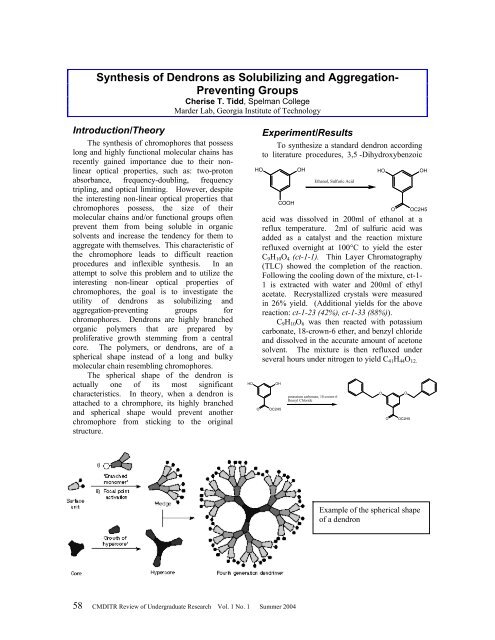CMDITR Review of Undergraduate Research - Pluto - University of ...
CMDITR Review of Undergraduate Research - Pluto - University of ...
CMDITR Review of Undergraduate Research - Pluto - University of ...
You also want an ePaper? Increase the reach of your titles
YUMPU automatically turns print PDFs into web optimized ePapers that Google loves.
Synthesis <strong>of</strong> Dendrons as Solubilizing and Aggregation-<br />
Preventing Groups<br />
Cherise T. Tidd, Spelman College<br />
Marder Lab, Georgia Institute <strong>of</strong> Technology<br />
Introduction/Theory<br />
The synthesis <strong>of</strong> chromophores that possess<br />
long and highly functional molecular chains has<br />
recently gained importance due to their nonlinear<br />
optical properties, such as: two-proton<br />
absorbance, frequency-doubling, frequency<br />
tripling, and optical limiting. However, despite<br />
the interesting non-linear optical properties that<br />
chromophores possess, the size <strong>of</strong> their<br />
molecular chains and/or functional groups <strong>of</strong>ten<br />
prevent them from being soluble in organic<br />
solvents and increase the tendency for them to<br />
aggregate with themselves. This characteristic <strong>of</strong><br />
the chromophore leads to difficult reaction<br />
procedures and inflexible synthesis. In an<br />
attempt to solve this problem and to utilize the<br />
interesting non-linear optical properties <strong>of</strong><br />
chromophores, the goal is to investigate the<br />
utility <strong>of</strong> dendrons as solubilizing and<br />
aggregation-preventing groups for<br />
chromophores. Dendrons are highly branched<br />
organic polymers that are prepared by<br />
proliferative growth stemming from a central<br />
core. The polymers, or dendrons, are <strong>of</strong> a<br />
spherical shape instead <strong>of</strong> a long and bulky<br />
molecular chain resembling chromophores.<br />
The spherical shape <strong>of</strong> the dendron is<br />
actually one <strong>of</strong> its most significant<br />
characteristics. In theory, when a dendron is<br />
attached to a chromphore, its highly branched<br />
and spherical shape would prevent another<br />
chromophore from sticking to the original<br />
structure.<br />
HO<br />
HO<br />
O<br />
Experiment/Results<br />
To synthesize a standard dendron according<br />
to literature procedures, 3,5 -Dihydroxybenzoic<br />
OC2H5<br />
acid was dissolved in 200ml <strong>of</strong> ethanol at a<br />
reflux temperature. 2ml <strong>of</strong> sulfuric acid was<br />
added as a catalyst and the reaction mixture<br />
refluxed overnight at 100°C to yield the ester<br />
C 9 H 10 O 4 (ct-1-1). Thin Layer Chromatography<br />
(TLC) showed the completion <strong>of</strong> the reaction.<br />
Following the cooling down <strong>of</strong> the mixture, ct-1-<br />
1 is extracted with water and 200ml <strong>of</strong> ethyl<br />
acetate. Recrystallized crystals were measured<br />
in 26% yield. (Additional yields for the above<br />
reaction: ct-1-23 (42%), ct-1-33 (88%)).<br />
C 9 H 10 O 6 was then reacted with potassium<br />
carbonate, 18-crown-6 ether, and benzyl chloride<br />
and dissolved in the accurate amount <strong>of</strong> acetone<br />
solvent. The mixture is then refluxed under<br />
several hours under nitrogen to yield C 41 H 44 O 12.<br />
OH<br />
OC2H5<br />
COOH<br />
OH<br />
Ethanol, Sulfuric Acid<br />
potassium carbonate, 18-crown-6<br />
Benzyl Chloride<br />
HO<br />
O<br />
O<br />
O<br />
O<br />
OC2H5<br />
OH<br />
Example <strong>of</strong> the spherical shape<br />
<strong>of</strong> a dendron<br />
58 <strong>CMDITR</strong> <strong>Review</strong> <strong>of</strong> <strong>Undergraduate</strong> <strong>Research</strong> Vol. 1 No. 1 Summer 2004




